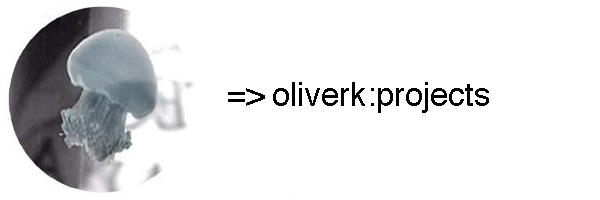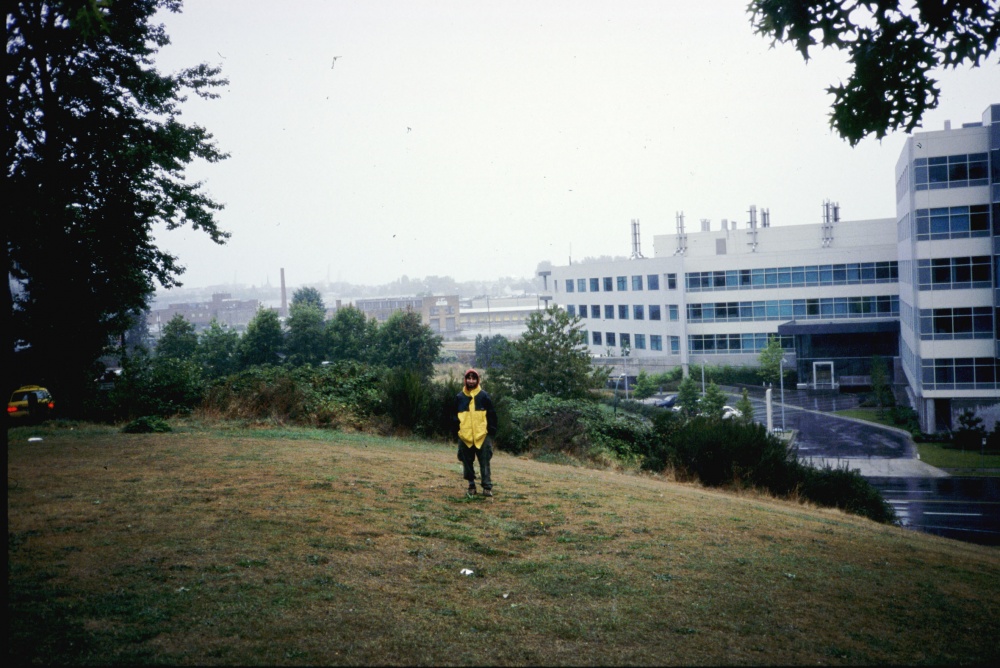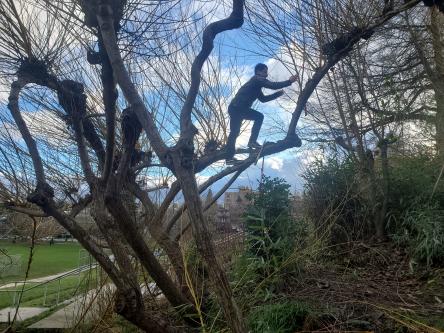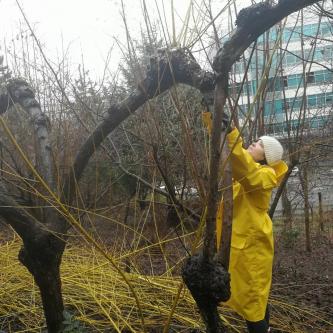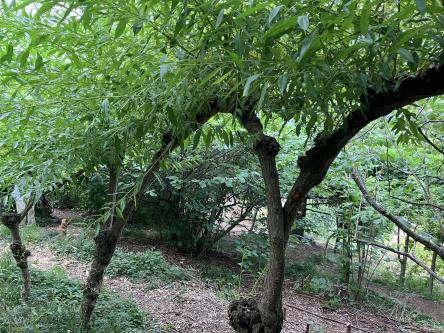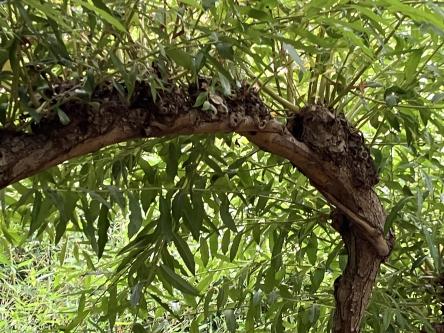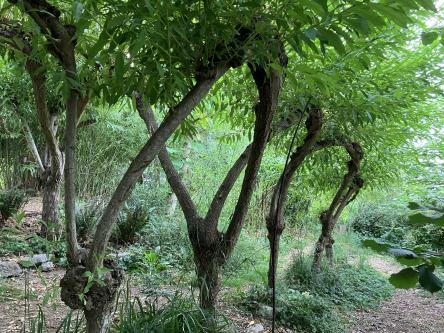Means of Production
Means of Production is a public land art project located at North China Creek Park in the Mount Pleasant neighbourhood of Vancouver, British Columbia.
I conceived the project as a botanical intervention to demonstrate techniques of community-scale ecoforestry in a low-income, inner city neighbourhood, as well as to frame questions about the loss of the notion of the 'commons' in the North American landscape.
The inspiration for the Means of Production project came to me during my work founding the nearby Cottonwood Gardens, where I initiated some plantings of bio-materials ( bamboo, willow, Paulownia and Black Locust) so we could make stakes, trellises and fencing for our produce gardens. It occurred to me then that there were a lot other areas of waste or underutilized urban land, perhaps less suited to the intensive production of food, that could be producing useful bio-materials and perhaps this could form the foundation of community micro-economic enterprise in the way that the traditional 'commons' has functioned for centuries in the context of Europe. The additional services such as wildlife habitat, carbon sequestration, recharging the water table and of course, community empowerment that such a scheme could provide made the concept seem all the more viable and thus the proposal for the 'Means of Production' project was born, its name an obvious reference to Karl Marx's notion of the physical infrastructure required to produce so-called 'wealth.' My idea to focus initially on the production of art and craft supplies came out of my proposition that the landscape itself could be an ongoing art piece, which, when managed by creative people, could serve as a kind of lab or platform where ongoing experiments with biomaterials could be carried out and the public engaged in wider aesthetic discussion as well as encouraged to participate in the site's ongoing stewardship.
Means of Production was intially implemented by me and members of the Environmental Youth Alliance with financial support from the Art & The Environment initiative of the Community Arts Council of Vancouver as well as the Vancouver Parks Board.
Work at the Means of Production site commenced in the fall of 2002 and is ongoing. The landscape is constantly changing as the plantings of heritage basket willow, Paulownia, bamboo, hazel, ash, iris and hollyhock are harvested and new growth cycles start up and the various on-site artistic interventions ebb and flow through time. The harvested materials form the basis of social practice initiatives led by various artists in conjunction with people from the surrounding neighbourhood. I continuing to document each layer as it continues to aggregate into an ever richer palimpsest of human and botanical activity.
In keeping with the open source intention of the the project, the Earthhand Gleaners Society formed and they now co-manage the site. They put on workshops using the materials grown on site as well as offer many other interactive and educational programs throughout the year.
We would be pleased to have you visit Means of Production, which is open to the public year round.
Here is a video made by Patti Fraser of the Pacific Cinematheque documenting the founding of the project:
Link to City of Vancouver Parks Dept. description of site
https://vancouver.ca/parks-recreation-culture/means-of-production.aspx
Slide Show:
The Means of Production Manifesto:
With its explicitly utilitarian didacticism and naturalistic horticultural arrangements, one might well ask:
“What makes The Means of Production a work of art?”
Clearly the project facilitates the production of art by directly furnishing materials for art making but is it itself a work of art?
At first glance, the plantings are quite pleasing to the eye, the bright varicoloured stems of willows and bamboo contrasting with the dark sculptured shapes of the coppiced trees.
In addition, Means of Production is paradigmatic; a working model of inner city forestry and neighbourhood self-sufficiency, an homage to arcadian tradition and ecological agit prop. But this is only part of the aesthetic equation.
In my previous land art work, (Cottonwood Gardens, Healing the Cut- Bridging the Gap, Memory Trees etc.), I have adopted what the late Fluxus artist Joseph Beuys called “the homeopathic role." Here, the artist, and by extension the work, become covert agents of social change.
Beuys, despite his stated aspirations, was himself extremely overt, caught up in the overblown celebrity culture of the twentieth century avant-garde. Yet some of his later works, notably Stadtverwaldung statt Staatverwaltung (also known as Seven Thousand Oaks) pointed out a way toward a new, more subtle artistic mandate.
Considering urban reforestation as art, moves us away from the pervasive banality of the artist as stylish maker of branded fetish objects, purveyed to an ever-shrinking audience of cognoscenti; the kind of art that can at best evoke some small frisson, or a knowing, ironic wink.
Means of Production abandons this game. There is no more secret handshake, no more “Fifteen minutes of fame.”
I succeed only when the viewers of my work forget about me and any cleverness of artifice and begin to experience the work completely as ambiance. Then, they might start asking the questions that I want them to ask. After numerous cycles of harvest and regrowth, any residual aura of me as artist or horticultural dramaturge will have disappeared. It will no longer matter.
That is when it gets interesting . . .
Because then the artwork will have receded into what Walter Benjamin called the optical subconscious – the artist’s unseen hand. The work no longer screams out, “ART”, but becomes part of the infrastructure, part of our assumptions, an internalized component of the urban visual field. In short: The new normal.
- planting willows
- young willows
- monolith
- first growth
- hand + stick = basket
- golden willows
- pollarded willows
- basketry workshop
- evolving landscape
- hillside after ten years
- Means of Production Video
- Grafted Willow Arch
- Pollarded Paulownia
- Pollarded and Grafted Willows
- Willow Arch
- Willow harvest 2022
- Willow harvest 2023
- basketry workshop in progress
- hazel gates
- hillside in spring
- newly harvested willow
- open source landscape
- summer willow
- the monolith after ten years
- willow edging and trellis
- willow harvest
- Paulownia wood musical instrument
projects:
events:
-
Thursday, March 20, 2025 - 12:00 - 13:00
-
Tuesday, April 26, 2022 - 03:30 - 16:30
-
Friday, April 1, 2022 - 18:00 - Monday, April 4, 2022 - 12:00
-
Friday, April 1, 2022 - 09:00 - Sunday, July 31, 2022 - 17:00
-
Wednesday, December 8, 2021 - 21:45 - 22:45
-
Friday, November 5, 2021 - 13:45 - 16:00
-
Tuesday, October 12, 2021 - 13:30 - 14:15
-
Monday, June 28, 2021 - 10:00 - 11:00
-
Thursday, March 19, 2020 - 12:00 - Sunday, March 22, 2020 - 00:00
-
Friday, October 25, 2019 - 21:00 - Sunday, October 27, 2019 - 23:00
-
Thursday, August 1, 2019 - 12:00 - Wednesday, October 2, 2019 - 00:00
-
Friday, April 26, 2019 - 21:30 - Saturday, April 27, 2019 - 00:30
-
Friday, March 29, 2019 - 23:00 - Sunday, March 31, 2019 - 21:00
-
Sunday, June 24, 2018 - 12:00 - Saturday, July 7, 2018 - 22:00
-
Friday, June 22, 2018 - 12:00 - Sunday, September 30, 2018 - 20:00
-
Saturday, June 9, 2018 - 12:00 - 19:00
-
Saturday, May 19, 2018 - 15:00 - Sunday, November 11, 2018 - 22:00
-
Sunday, April 22, 2018 - 13:00 - 23:00
-
Friday, April 13, 2018 - 22:00 - Sunday, April 15, 2018 - 17:00
-
Friday, January 26, 2018 - 09:30 - 11:00
-
Saturday, July 1, 2017 - 03:00 - Sunday, August 27, 2017 - 03:00
-
Friday, May 26, 2017 - 12:00 - Saturday, May 27, 2017 - 15:00
-
Sunday, May 14, 2017 - 13:00 - 17:00
-
Sunday, April 30, 2017 - 20:00 - 22:30
-
Sunday, April 9, 2017 - 18:00 - 20:00
-
Tuesday, November 15, 2016 - 14:00 - 16:00
-
Tuesday, April 12, 2016 - 17:00 - 18:30
-
Tuesday, March 1, 2016 - 12:00 - Monday, June 6, 2016 - 21:00
-
Thursday, February 25, 2016 - 14:15 - 14:30
-
Tuesday, February 16, 2016 - 14:15 - Wednesday, February 17, 2016 - 00:45
-
Wednesday, December 2, 2015 - 22:00 - Sunday, December 6, 2015 - 22:00
-
Saturday, November 21, 2015 - 19:00 - 21:00
-
Friday, September 18, 2015 - 03:00 - Monday, December 7, 2015 - 02:59
-
Saturday, May 16, 2015 - 16:00 - 19:00
-
Friday, April 17, 2015 - 19:00 - Saturday, April 18, 2015 - 22:00
-
Wednesday, February 25, 2015 - 03:00 - Wednesday, March 25, 2015 - 03:00
-
Tuesday, November 11, 2014 - 20:00 - Wednesday, November 12, 2014 - 00:00
-
Monday, September 22, 2014 - 12:00 - Sunday, September 28, 2014 - 02:00
-
Wednesday, July 30, 2014 - 12:00 - Monday, August 4, 2014 - 01:00
-
Tuesday, July 22, 2014 - 13:00 - Friday, July 25, 2014 - 19:00
-
Wednesday, March 19, 2014 - 21:00 - 22:00
-
Saturday, March 15, 2014 - 12:00 - Friday, March 28, 2014 - 12:00
-
Thursday, March 6, 2014 - 19:00 - 21:00
-
Tuesday, February 25, 2014 - 14:00 - 15:15
-
Friday, October 25, 2013 - 11:30 - Saturday, October 26, 2013 - 19:00
-
Saturday, September 28, 2013 - 20:30 - 23:30
-
Monday, September 16, 2013 - 03:00 - Wednesday, September 25, 2013 - 02:59
-
Sunday, May 26, 2013 - 18:00 - 21:00
-
Saturday, May 25, 2013 - 14:00
-
Thursday, May 9, 2013 - 18:00
-
Thursday, February 21, 2013 - 22:00 - Friday, February 22, 2013 - 00:00
-
Thursday, February 7, 2013 - 17:00 - 19:00
-
Tuesday, December 4, 2012 - 22:30
-
Sunday, September 30, 2012 - 21:30 - Monday, October 1, 2012 - 00:00
-
Wednesday, September 26, 2012 - 20:00 - Thursday, September 27, 2012 - 00:00
-
Saturday, August 25, 2012 - 16:00 - 19:00
-
Friday, June 1, 2012 - 14:00 - 16:00
-
Friday, February 17, 2012 - 21:00
-
Thursday, January 26, 2012 - 15:00 - 17:00
-
Friday, November 18, 2011 - 21:30 - Monday, November 21, 2011 - 00:00
-
Sunday, September 18, 2011 - 13:00
-
Saturday, September 17, 2011 - 13:00 - 17:00
-
Saturday, June 25, 2011 - 13:00
-
Thursday, June 23, 2011 - 22:00
-
Wednesday, June 22, 2011 - 22:00
-
Thursday, May 5, 2011 - 22:00
-
Thursday, October 28, 2010 - 22:00 - Friday, October 29, 2010 - 01:00
-
Tuesday, June 1, 2010 - 21:00 - Wednesday, June 2, 2010 - 00:00
-
Friday, April 16, 2010 - 23:00
-
Wednesday, March 31, 2010 - 22:00 - Thursday, April 1, 2010 - 00:00
